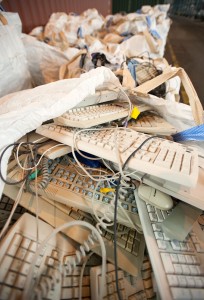eDay 2010 facts
 eDay will take place on Saturday 6th November 2010, 9am – 3pm, in over 40 locations across New Zealand.
eDay will take place on Saturday 6th November 2010, 9am – 3pm, in over 40 locations across New Zealand.
eDay is a simple, free and effective way to recycle old computer equipment and mobile phones in an environmentally sound way. eDay is open to households, schools and small businesses.
Since eDay’s inception in 2007, approximately 39,900 cars have dropped off 196,000 items of computer and computer-related waste for safe recycling, diverting 2,337 tonnes of e-waste from landfills.
The eDay 2010 event goal is to divert over 1,000 tonnes of e-waste from local landfills. Recycling electronic waste (e-waste) enables the recovery and reuse of valuable materials and ensures toxic materials are not buried in our landfills – so it’s better for our environment.
What can people drop-off? Computer hardware, monitors, computer speakers, scanners, keyboards, mice, printers and cartridges, games consoles, laptops, mobile phones, networking equipment.
eDay is an initiative of the Computer Access New Zealand Trust (CANZ). CANZ is a not-for-profit trust set up by the 2020 Communications Trust with support from the Ministry of Education. This year, eDay will be run by the eDay New Zealand (eNZ) Trust, a new independent community trust set up by CANZ members specifically to promote responsible recycling of electronic waste in New Zealand.
e-waste is the fastest growing type of waste in the world and is more toxic than normal household rubbish.
Computers contain approximately 15% glass and, if thrown away in landfills, the glass will never decompose.1
A single computer can contain up to 2kg of lead, and the complex mixture of materials make PCs very difficult to recycle which is why they are sent to e-waste recycling specialists.1
Recycled glass can even be used to provide sand for beaches that have been depleted by erosion.2
There is a chemical in LCD screens that can be recovered to manufacture medicine, pills and bandages.2
The European Union banned e-waste from landfills in the 1990s, and current laws hold manufacturers responsible for e-waste disposal.3
It’s energy efficient to rebuild old computers, but only about 2% of PCs ever find their way to a second user.3
According to the Environmental Protection Agency, in the USA there were 2.9million tonnes of e-waste discarded in 2006.4
• According to www.e-takeback.org, 133,000 PCs are discarded in the United States every day.
The recovered metals in cellphones can be used to make car parts, plumbing faucets and piping, and gold or silvery jewellery.4
The plastic on cellphones can also be recycled into new products such as garden furniture, non-food containers and replacement automotive parts. Due to its high thermal value, the plastic could alternatively be used as a fuel.4
loading...
loading...
Tags: eday



Voices of our community